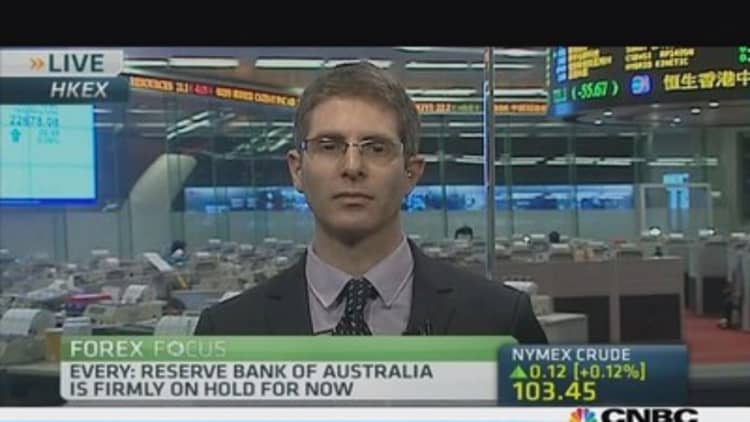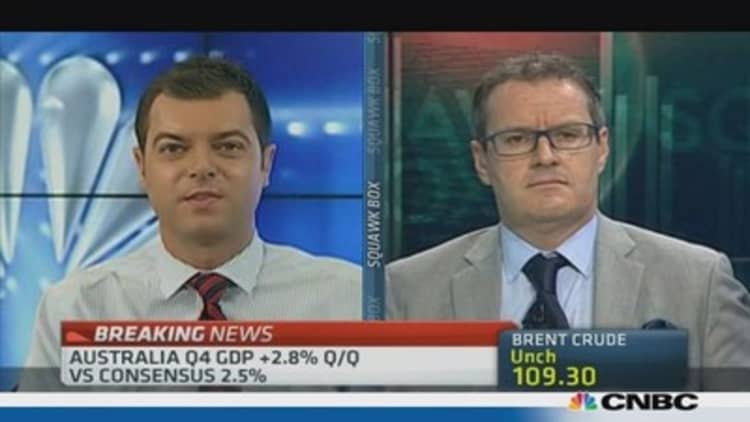
A pickup in Australia's gross domestic product (GDP) print on Wednesday gave its currency a boost, but analysts told CNBC it was too soon to get excited about a sustained recovery.
The world's 12th largest economy grew 0.8 percent last quarter, above analyst expectations of a 0.6 percent rise. On an annual basis, the economy expanded 2.8 percent, up from 2.3 percent in the third quarter and closer to the usual pace of growth it's enjoyed in recent years.
A pick-up in resource exports and consumer spending was behind the improvement in the overall figure, while a decline in business spending weighed on chances of a stronger pick-up.
(Read More: Is Australia's stock market getting lopsided?)
Traders piled into the Australian dollar in response, pushing it up past the psychologically important 90 cents level, though it had fallen back slightly to trade $0.8948 by mid-morning in Asia.
"It's just on trend, it snapped back from last quarter, but the main sector that is contributing to growth is still mining, whereas manufacturing, wholesale trading and energy are still going backwards, which is disappointing," Evan Lucas, strategist at IG told CNBC on Monday.
Australia - often referred to as the 'lucky country' - stands out from other westernized economies, as a once-in-a-century mining boom helped fuel high levels of growth over the past few decades.
However, now the boom is largely perceived to be over, the nation's central bank has been forced to lower interest rates eight times since late 2011 in an effort to stimulate other parts of the economy. A slowdown in China and other major trading partners has also taken its toll.
(Read More: Australia's jobs picture is getting uglier)
Analysts told CNBC they doubted whether the positive fourth-quarter GDP number showed the government's strategy of refocusing the economy from one based on mining revenues more towards other parts of the economy was working.
"The domestic economy hasn't shown enough of an improvement to show its going to compensate for the drop-off in mining, lower commodity prices, and the government's fiscal tightening," Ric Spooner, chief analyst at CMC Markets, told CNBC on Wednesday.
Spooner said the data indicated "signs of life" in the Australian economy, including the pick-up in residential construction, retail sales and a slight decline in the household savings rate, but said business spending remained at recalcitrant levels, showing confidence in the Australian economy was still low.

Household spending rose 0.8 percent in the December quarter, while total investment housing was up 1 percent over the three month period.
Total gross fixed capital formation, which includes investment by households, businesses and government, fell 1.2 per cent in the quarter and was down 2.4 per cent over the year.
More bullish commentators, including AMP Capital's Shane Oliver, however, interpreted the data in a more positive light.
"I would be a bit more positive. It's not a bad growth rate for an economy that has seen mining fall off a cliff, and it's not bad on a global scale either," Oliver told CNBC.
(Read More: Australia stocks no longer expensive: Goldman)
Oliver pointed out that Australia's trade performance had seen a turnaround in his view. Net exports in the fourth quarter contributed 0.6 percentage points to GDP growth.
"If you ally that with forward looking data, such as building approvals which picked up 35 percent over the past year, the pick-up in business confidence together with the jobs market bottoming out, I actually think it's quite positive," he added.
But IG's Lucas said there were still some worrying headwinds evident once you drilled down into the data. He pointed to the household savings ratio, which at 9.7 percent remained near a record high, while private capex spending remained at 20-year lows.
(Read More: Are fears ofan Australian housing bubble overblown?)
"This shows that the consumption ideal that the RBA wants still isn't happening. We'll have to wait for the Q1 GDP figure to back it up before we can be more positive," he added.
All the analysts CNBC spoke to said they did not expect the GDP data to change the Reserve Bank of Australia's neutral stance.
— By CNBC's Katie Holliday: Follow her on Twitter @hollidaykatie


